Abstract
Screening for hearing loss in the first year of life, using the distraction test, remains the responsibility of health visitors in most health districts in the United Kingdom. We have evaluated the screening procedure used routinely in one health region in a population of infants at increased risk of sensorineural deafness. They were infants who weighed less than 2000 g at birth or infants who weighed 2000 g or more at birth and who spent more than 24 hours in a special care nursery. The infants' responses to a distraction test were recorded by health visitors and sent to the project office. The results were compared with information from a regional register of early childhood impairment that included children in whom sensorineural deafness had been diagnosed before the age of 3 years. The register had been compiled using information from a wide range of sources. When used in this high risk population the distraction test was sensitive (91%), but nonspecific (82%). The effectiveness of the screening programme was limited, however, because there was an increased risk of deafness among infants who missed being screened by health visitors. In addition, 71% of the deaf infants on the register were not in the high risk population.
Full text
PDF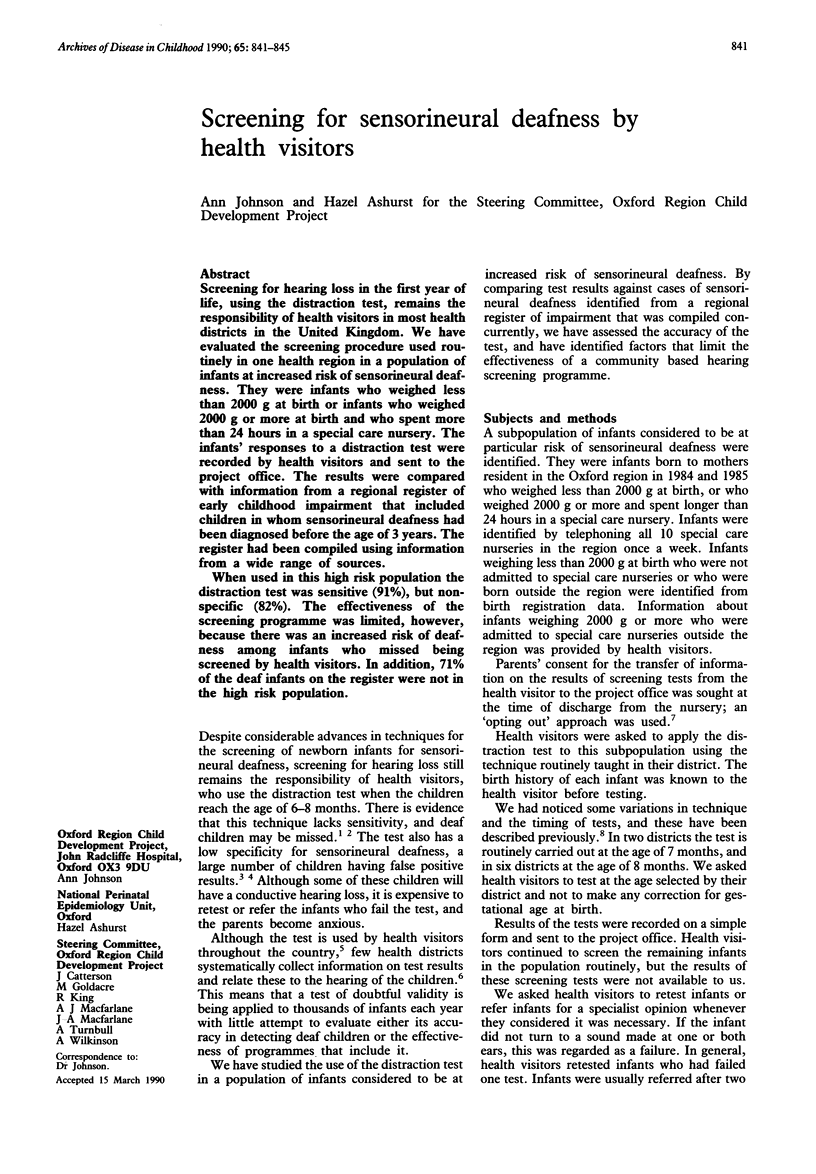
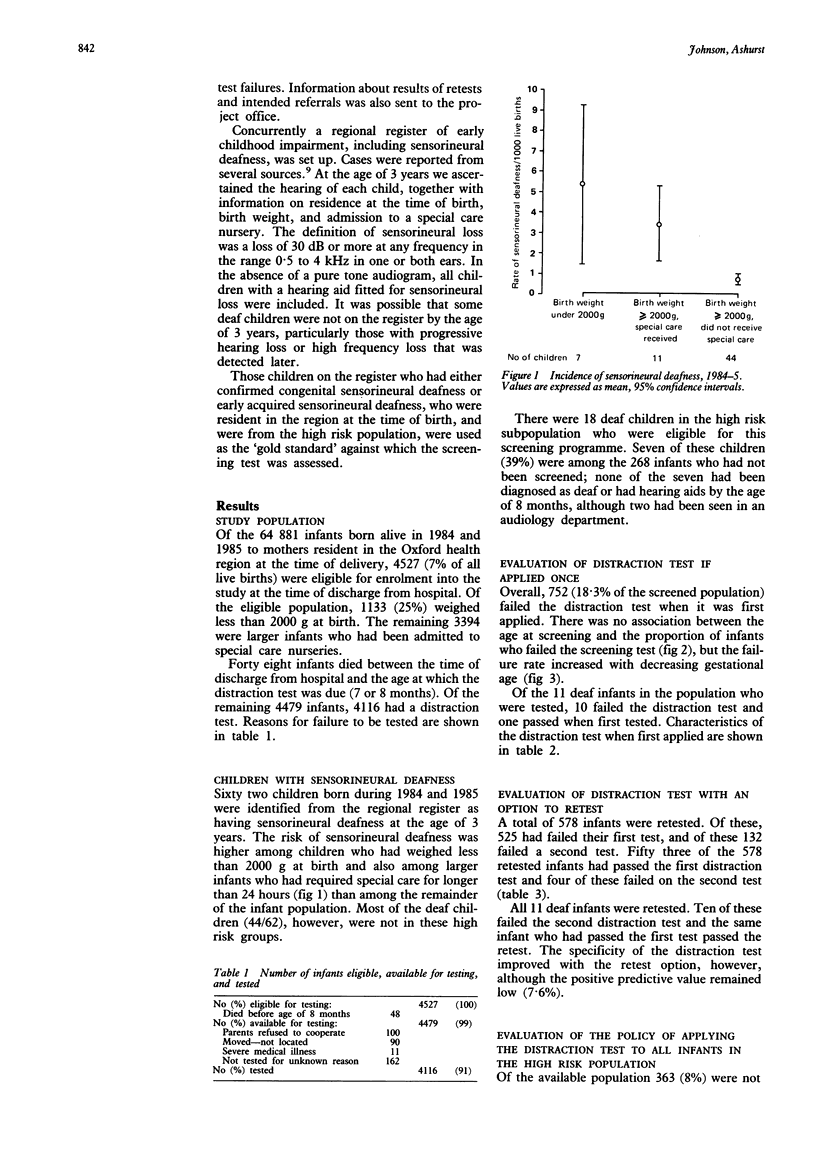
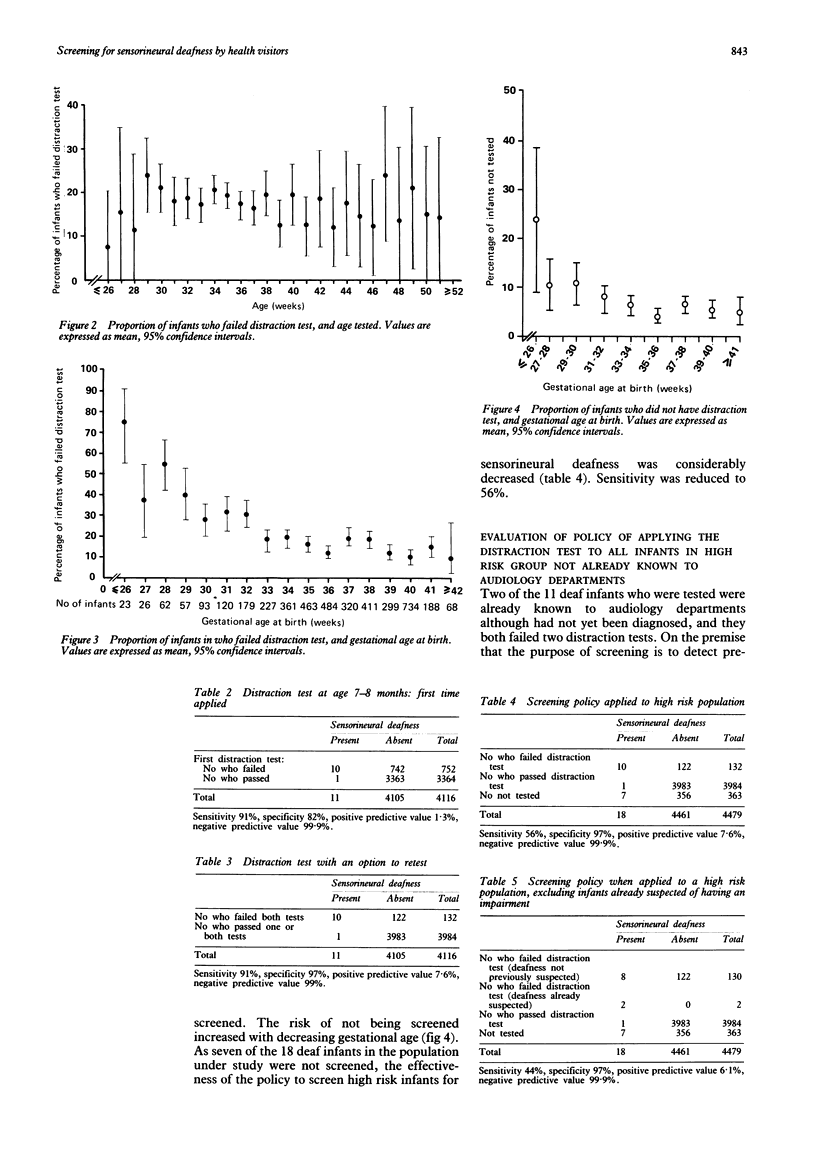
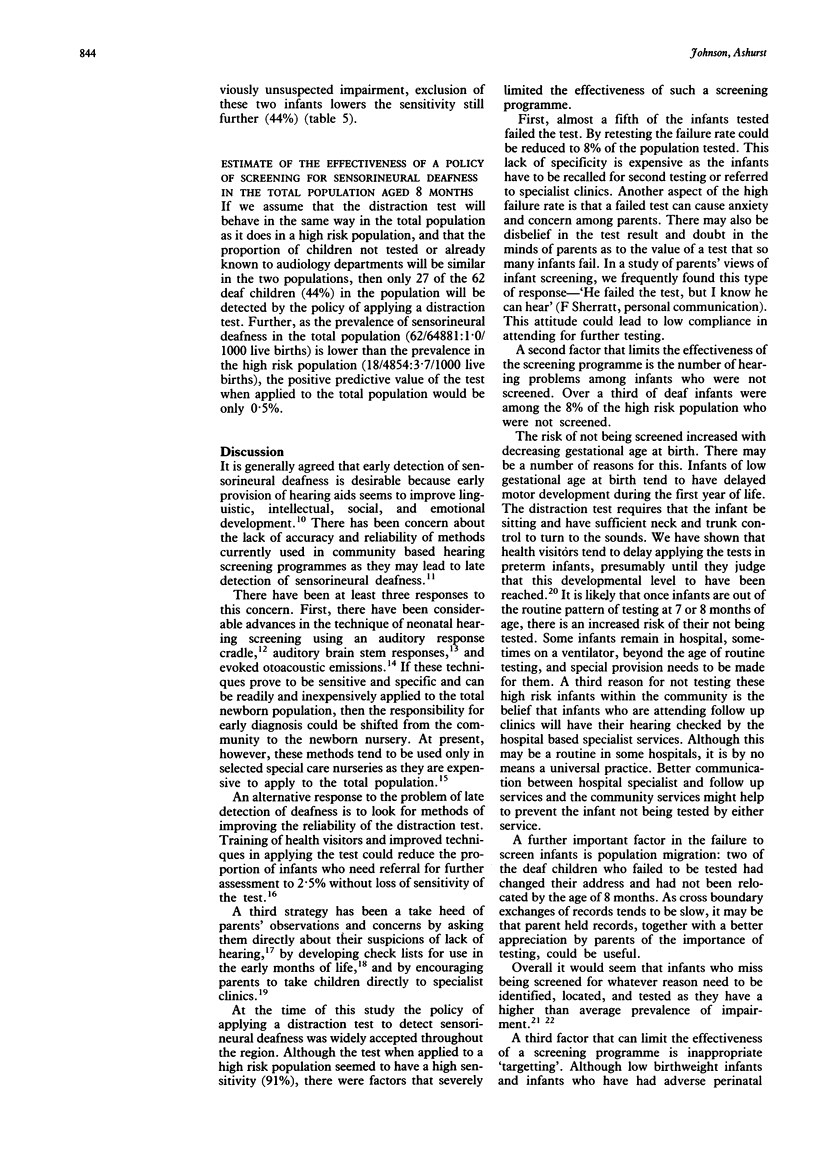
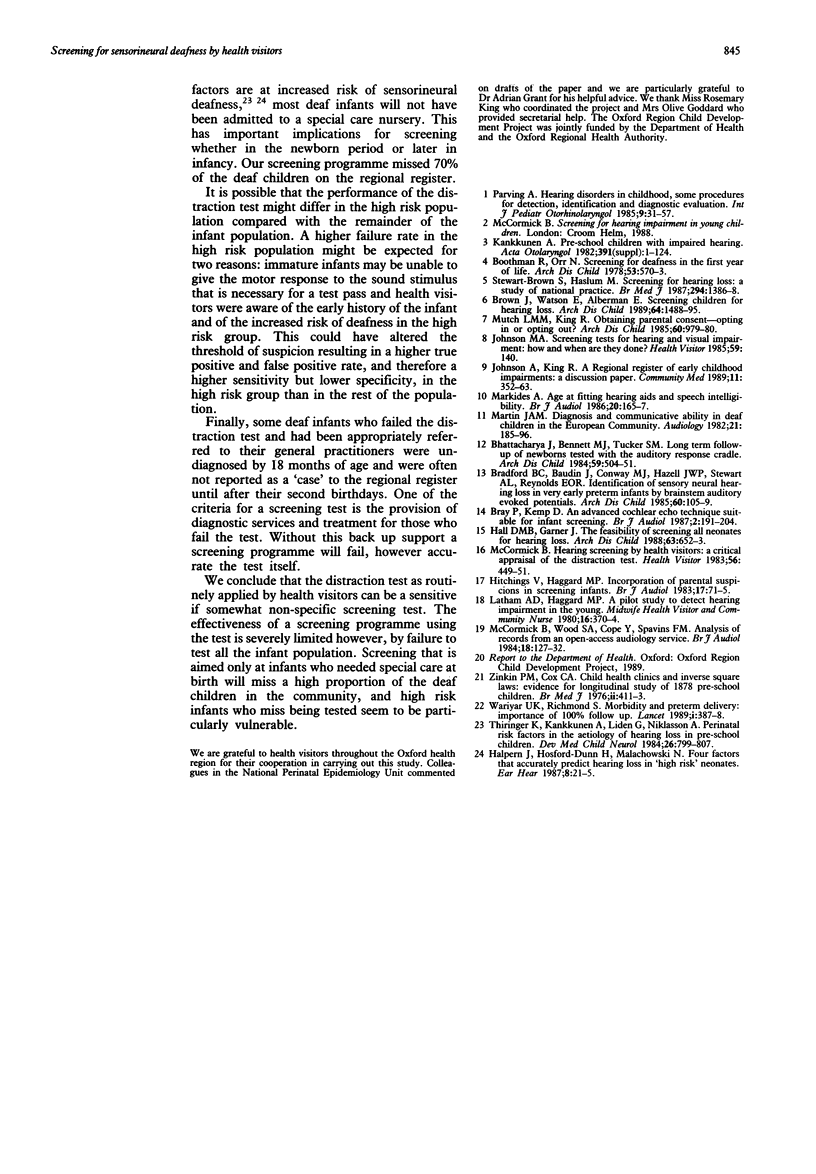
Selected References
These references are in PubMed. This may not be the complete list of references from this article.
- Bhattacharya J., Bennett M. J., Tucker S. M. Long term follow up of newborns tested with the auditory response cradle. Arch Dis Child. 1984 Jun;59(6):504–511. doi: 10.1136/adc.59.6.504. [DOI] [PMC free article] [PubMed] [Google Scholar]
- Boothman R., Orr N. Value of screening for deafness in the first year of life. Arch Dis Child. 1978 Jul;53(7):570–573. doi: 10.1136/adc.53.7.570. [DOI] [PMC free article] [PubMed] [Google Scholar]
- Bradford B. C., Baudin J., Conway M. J., Hazell J. W., Stewart A. L., Reynolds E. O. Identification of sensory neural hearing loss in very preterm infants by brainstem auditory evoked potentials. Arch Dis Child. 1985 Feb;60(2):105–109. doi: 10.1136/adc.60.2.105. [DOI] [PMC free article] [PubMed] [Google Scholar]
- Bray P., Kemp D. An advanced cochlear echo technique suitable for infant screening. Br J Audiol. 1987 Aug;21(3):191–204. doi: 10.3109/03005368709076405. [DOI] [PubMed] [Google Scholar]
- Brown J., Watson E., Alberman E. Screening infants for hearing loss. Arch Dis Child. 1989 Oct;64(10):1488–1495. doi: 10.1136/adc.64.10.1488. [DOI] [PMC free article] [PubMed] [Google Scholar]
- Hall D. M., Garner J. Feasibility of screening all neonates for hearing loss. Arch Dis Child. 1988 Jun;63(6):652–653. doi: 10.1136/adc.63.6.652. [DOI] [PMC free article] [PubMed] [Google Scholar]
- Halpern J., Hosford-Dunn H., Malachowski N. Four factors that accurately predict hearing loss in "high risk" neonates. Ear Hear. 1987 Feb;8(1):21–25. doi: 10.1097/00003446-198702000-00004. [DOI] [PubMed] [Google Scholar]
- Hitchings V., Haggard M. P. Incorporation of parental suspicions in screening infants' hearing. Br J Audiol. 1983 May;17(2):71–75. doi: 10.3109/03005368309078910. [DOI] [PubMed] [Google Scholar]
- Johnson A., King R. A regional register of early childhood impairments: a discussion paper. The Steering Committee of the Oxford Region Child Development Project. Community Med. 1989 Nov;11(4):352–363. [PubMed] [Google Scholar]
- Kankkunen A. Pre-school children with impaired hearing in Göteborg 1964-1980. Acta Otolaryngol Suppl. 1982;391:1–124. doi: 10.3109/00016488209108896. [DOI] [PubMed] [Google Scholar]
- Latham A. D. A pilot study to detect hearing impairment in the young. Midwife Health Visit Community Nurse. 1980 Sep;16(9):370–374. [PubMed] [Google Scholar]
- Markides A. Age at fitting of hearing aids and speech intelligibility. Br J Audiol. 1986 May;20(2):165–167. doi: 10.3109/03005368609079011. [DOI] [PubMed] [Google Scholar]
- Martin J. A. Diagnosis and communicative ability in deaf children in the European Community. Audiology. 1982;21(3):185–196. doi: 10.3109/00206098209072738. [DOI] [PubMed] [Google Scholar]
- McCormick B. Hearing screening by health visitors: a critical appraisal of the distraction test. Health Visit. 1983 Dec;56(12):449–451. [PubMed] [Google Scholar]
- McCormick B., Wood S. A., Cope Y., Spavins F. M. Analysis of records from an open-access audiology service. Br J Audiol. 1984 Aug;18(3):127–132. doi: 10.3109/03005368409078940. [DOI] [PubMed] [Google Scholar]
- Mutch L., King R. Obtaining parental consent--opting in or opting out? Arch Dis Child. 1985 Oct;60(10):979–980. doi: 10.1136/adc.60.10.979. [DOI] [PMC free article] [PubMed] [Google Scholar]
- Parving A. Hearing disorders in childhood, some procedures for detection, identification and diagnostic evaluation. Int J Pediatr Otorhinolaryngol. 1985 Jun;9(1):31–57. doi: 10.1016/s0165-5876(85)80003-3. [DOI] [PubMed] [Google Scholar]
- Stewart-Brown S., Haslum M. N. Screening for hearing loss in childhood: a study of national practice. Br Med J (Clin Res Ed) 1987 May 30;294(6584):1386–1388. doi: 10.1136/bmj.294.6584.1386. [DOI] [PMC free article] [PubMed] [Google Scholar]
- Thiringer K., Kankkunen A., Lidén G., Niklasson A. Perinatal risk factors in the aetiology of hearing loss in preschool children. Dev Med Child Neurol. 1984 Dec;26(6):799–807. doi: 10.1111/j.1469-8749.1984.tb08174.x. [DOI] [PubMed] [Google Scholar]
- Zinkin P. M., Cox C. A. Child health clincs and inverse care laws: evidence from longitudinal study of 1878 pre-school children. Br Med J. 1976 Aug 14;2(6032):411–413. doi: 10.1136/bmj.2.6032.411. [DOI] [PMC free article] [PubMed] [Google Scholar]


